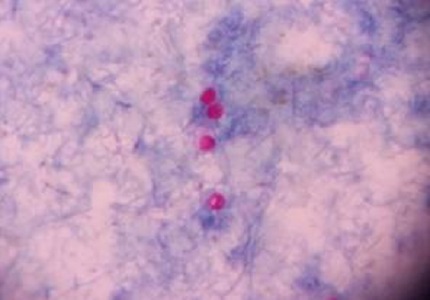Study of opportunistic intestinal parasitic infections in people living with HIVand their relationship with immune status
Abstract
Introduction: Diarrhea is one of the most common complaintspeople living with HIV(PLHIV), occurring in almost 90% of them. Intestinal parasites are one of the main causes of diarrhea in developing countries.
Objective: The present study was undertaken to detect enteric parasites in PLHIV with different levels of immune status (CD 4+ Counts).
Materials and Methods: The study included a total of 209 HIV seropositive subjects. Stool samples from each subject was examined microscopically for the presence of ova and cysts using wet mount preparations and stained smears (modified ZN stain).
Results: Enteric pathogens were detected in 57 (27.27%) of the 209 patients. The parasites identified were Cryptosporidium (25), Isospora belli (3), Strongoloides larvae (2), Ascaris ova (1).In our study it was observed that the prevalence of cryptosporidium in HIV sero-positive subjects was 49.01%, 33.33%, 17.6% in those having CD4 <200, 200-499, >500 cells/μl respectively.
Conclusion: Intestinal opportunistic parasitic infections were detected in 27.27 % among HIV-seropositive patients. Cryptosporidiumis an important emerging pathogen in HIV-seropositive individuals with or without symptoms.Early detection of opportunistic intestinal parasitic infections using simple techniques like wet mount and modified ZN staining will help in the timely management and will improve the quality of life of HIV infected individuals.
Downloads
References
S.V. Kulkarni, R. Kairon, S.S. Sane, P.S. Padmawar, V.A. Kale, M.R. Thakar S.M. Mehendale& A.R. Risbud. Opportunistic parasitic infections in HIV/AIDS patients presenting with diarrhoea by the level of immunesuppression. Indian J Med Res 130(1), 2009, pp 63-66. PMID:19700803.
Nilesh S Chavan and Swati N Chavan. Intestinal parasitic infections in HIV infected patients, Int.J.Curr.Microbiol.App.Sci (2014) 3(2): 265-270. ISSN: 2319-7706.
Rajeshwari P R. Study of opportunistic intestinal parasitic infections in HIV seropositive patients at a tertiary care teaching hospital in Karnataka, India. International Journal of Contemporary Medical Research 2016;3(8):2219-2222.
K Gupta, M Bala, M Deb, S Muralidhar, DK Sharma, Prevalence of intestinal parasitic infections in HIV-infected individuals and their relationship with immune status, Indian Journal of Medical Microbiology, (2013) 31(2): 161-165. DOI: http://www.ijmm.org/text.asp?2013/31/2/161/115247.
Nissapatorn V, Sawangjaroen N. Parasitic infections in HIV infected individuals: Diagnostic & therapeutic challenges. Indian J Med Res 2011; 134:878-97. Doi: https://dx.doi.org/10.4103%2F0971-5916.92633.
Swathirajan CR, Vignesh R, Pradeep A, Solomon SS, Solomon S, Balakrishnan P. Occurrence of enteric parasitic infections among HIV-infected individuals and its relation to CD4 T-cell counts with a special emphasis on coccidian parasites at a tertiary care centre in South India. Indian J Med Microbiol 2017; 35:37-40.DOI: https://doi.org/10.4103/ijmm.IJMM_16_164.
Mathur MK, Verma AK, Makwana GE, Sinha M. Study of opportunistic intestinal parasitic infections in human immunodeficiency virus/acquired immunodeficiency syndrome patients. J Global Infect Dis 2013;5:164-7.Doi: https://dx.doi.org/10.4103%2F0974-777X.122012.
Mitra S, Mukherjee A, Khanra D, Bhowmik A, Roy K, Talukdar A. Enteric parasitic infection among antiretroviral therapy Naïve HIV-seropositive people: Infection begets infection-experience from Eastern India. J Global Infect Dis 2016;8:82-6. doi: https://dx.doi.org/10.4103%2F0974-777X.182124. PMCID: PMC4879795.
Willemot P, Klein MB (2004) Prevention of HIV-associated opportunistic infections and diseases in the age of highly active antiretroviral therapy. Expert Rev Anti Infect Ther 2:521–532.
Pavie J, Menotti J, Porcher R, Donay JL, Gallien S, Sarfati C, Derouin F, Molina JM. Prevalence of opportunistic intestinal parasitic infections among HIV-infected patients with low CD4 cells counts in France in the combination antiretroviral therapy era.Int J Infect Dis. 2012 Sep;16(9):e677-9. doi: https://doi.org/10.1016/j.ijid.2012.05.1022. Epub 2012 Jul 6.
Garcia LS, Bruckner DA, Brewer TC, Shimizu RY.Techniques for the recovery and identification of Cryptosporidium oocysts from stool specimens.J ClinMicrobiol. 1983 Jul;18(1):185-90.
Attili SV, Gulati AK, Singh VP, Varma DV, Rai M, Sundar S. Diarrhea, CD4 counts and enteric infections in a hospital - based cohort of HIV-infected patients around Varanasi, India.BMC InfectDis.2006Mar1;6:39.
Vyas N, Sood S, Sharma B, Kumar M. The Prevalence of Intestinal Parasitic Infestation and the Related Profile of the CD4 (+) Counts in HIV/AIDS People with Diarrhoea in Jaipur City.J Clin Diagn Res. 2013 Mar;7(3):454-6. doi: https://dx.doi.org/10.7860%2FJCDR%2F2013%2F4817.2797. Epub 2013 Mar 1.
Ahmed NH, Chowdhary A.Pattern of co-infection by enteric pathogenic parasites among HIV sero-positive individuals in a Tertiary Care Hospital, Mumbai, India.Indian J Sex Transm Dis.2015Jan-Jun;36(1):40-7. doi: https://dx.doi.org/10.4103%2F2589-0557.156707.
Ajjampur SSR, Sankaran P, Kang G. Cryptosporidium species in HIV-infected individuals in India: An overview. Nat Med J Ind. 2008; 21:178-84. PMID: 19267039.



 OAI - Open Archives Initiative
OAI - Open Archives Initiative


